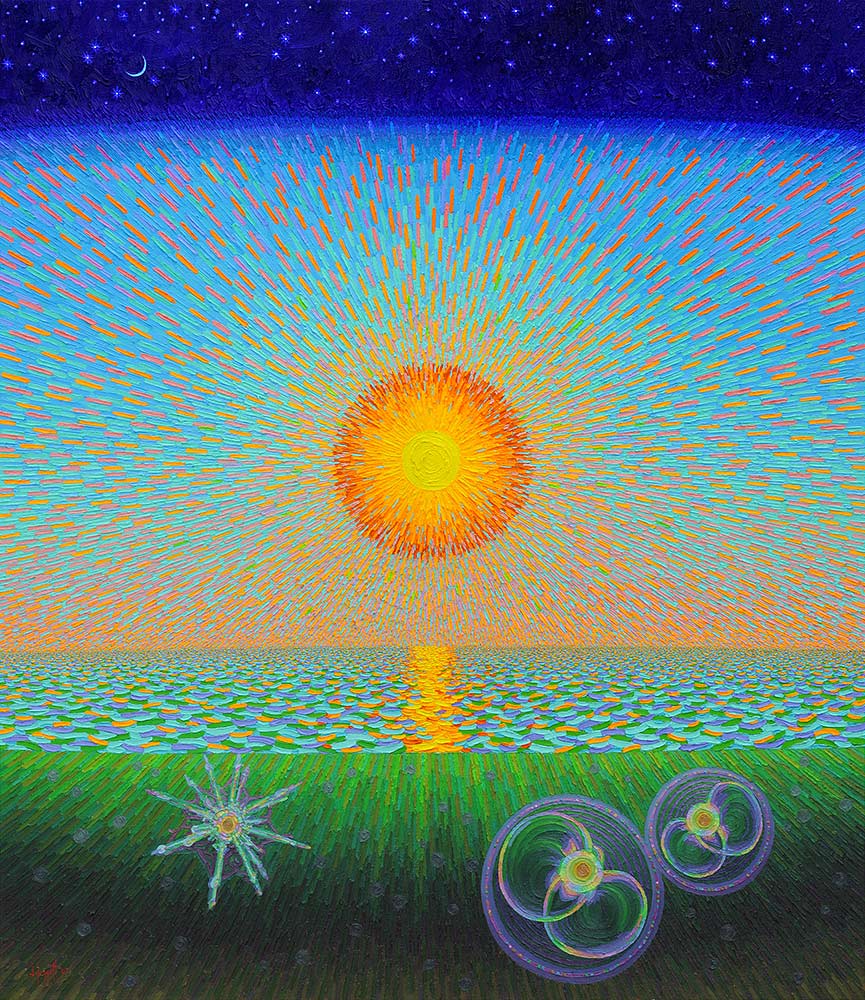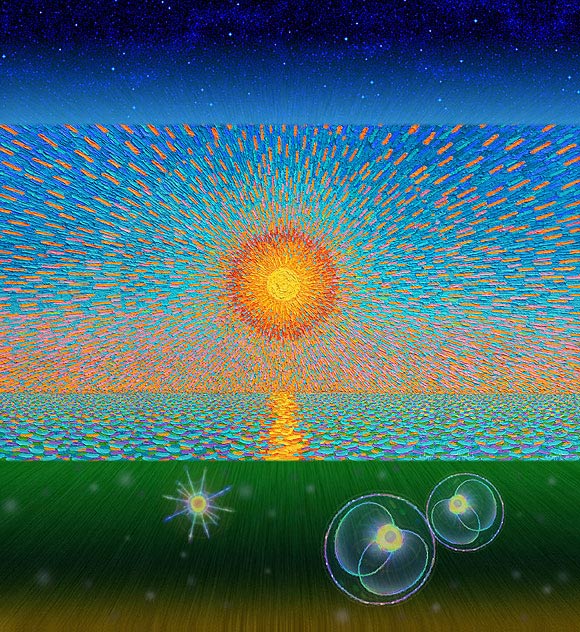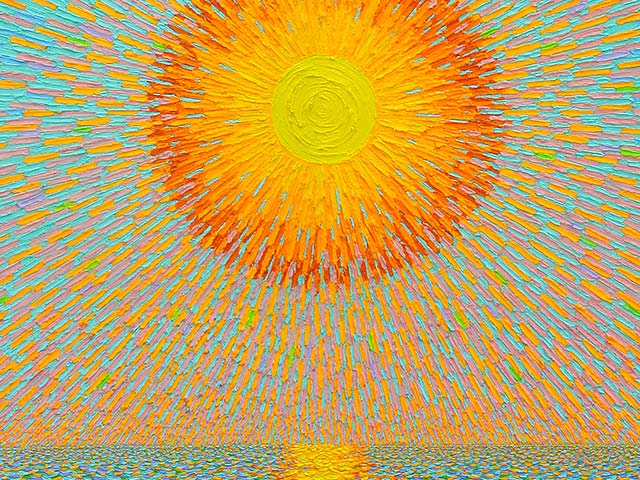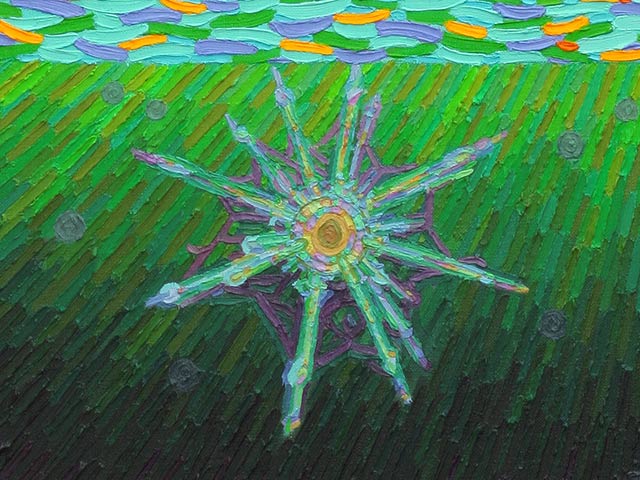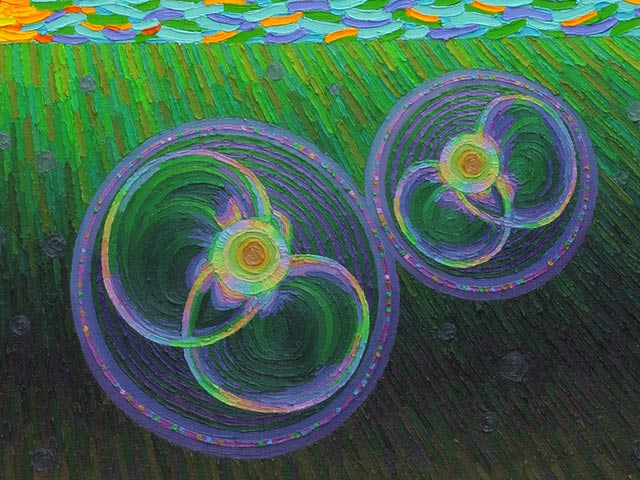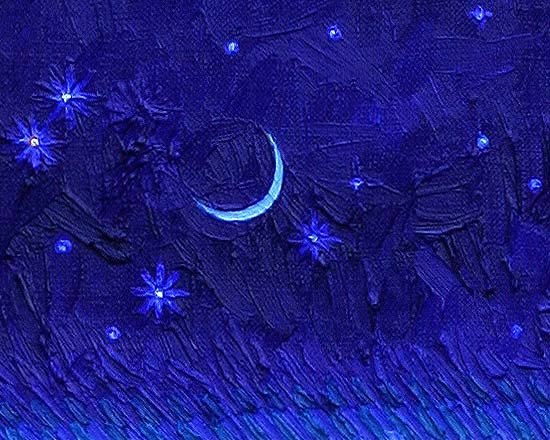112 cm (w) x 97 cm (h), oil paints on linen canvas.
Date produced: Jan - May 2007
This is an extended development of a previous painting titled “The Sun”. I was very happy with “The Sun” and after some time looking at it, I wondered about adding a section above the painting (showing an extention into space) and a section below (showing a view under the surface of the water).
The main reasons for considering this extended composition were to:
-
build on a design that was already an excellent foundation. “The Sun” is still one of my favourite paintings.
-
to include more obvious references to:
-
our sun’s place within the universe,
-
the role that the sun played in creating life on our planet, and
-
the role that the sun plays in sustaining life on our planet.
The ideas within the second reason above come from an understanding of life that is based on scientific research - seeing our sun as just one of millions of other suns in the universe; life on our planet developing from the product of the complex soup of chemicals in the sea, the action of sunlight on some of those chemicals, the temperature of the sea water (from the sunlight), the atmosphere, and all of the other special conditions that were met (experiments in the 1950s produced ‘simple’ life-building-blocks by reproducing conditions of our planet’s early atmosphere and seas and conducting a number of high voltage sparks through it all [like lightning bolts] - all derived from rigorous scientific research); and 99% of life on our planet being based on a supply of plant life (mostly in the form of single-celled sea algae) that produces food and oxygen from sunlight, water and carbon dioxide.
I composed a mock-up of my extended design on the computer (shown below), from a photograph of the original painting.
In producing this major painted version, I revisited and questioned many of the design aspects of the computer mock-up. I liked the aspect of having different types of view combined within the one image - e.g. a microscopic view next to a human-scale view, next to a wider distant ‘overview’. I gave the whole image a strong textural pattern, mainly radiating from the sun, like the original painting this idea is based on. The phytoplankton, single celled algae, were given their own organised textures, based on their own forms. I decided to go with slightly curved lines for the horizon and the junction between ‘above the surface of the sea’ and ‘below the surface of the sea’. I believe the slightly curved horizon gives the image a sense of the curvature of the planet. The curved lines also provide more dynamic interactions between the areas. There was more modulation put into tones of the underwater region, with indications of sun rays penetrating into the dark waters. I’ve tried to indicate the earth’s thin layer of bluish atmosphere within the junction between the region of space and the region of sunlit atmosphere. I added a small crescent moon, to help the expression of the space region.
In my computer composition, I had soft light forms in the water region, something I noticed in several microscope photographs that I had seen of phytoplankton. I assume they are floating particles, or something similar. In the painting, those forms were painted with more subtle differences of tone to the water, and take on a slightly different feel. I felt that their new feel was more useful for the interpretation of the painting (possibly suggesting the onset of interference to these fundamental processes from pollution).
This painting was quite different to the type of artwork I had been producing at the time (pastels or other dry media on paper, produced on-site). I hadn’t produced an oil painting for more than ten years. I produced this painting in a studio I put together especially for it (actually a converted garage). I built a substantial easel to paint it on, and I built some portable lights that used daylight coloured lamps. This meant that I could paint equally well during the day and at night. Every now and then, I would take it outside to check the colours in true daylight, but the lighting I used was found to be very close to daylight. I found working in an indoor studio was quite difficult at times, because it felt like I was spending a lot of time disconnected from the world at large. I enjoy interacting with the outside world, whether it’s while travelling to a site where I’m working on a piece, or being ‘interrupted’ by insects or birds that are living their lives nearby while I work. Just seeing the changes in the light throughout the day is interesting, and comforting, let alone changes in the weather, or in the seasons, etc.
I am very pleased to have been able to get this painting to a finished state (after working on it for the best part of about 4 months). I may have to revise it in the future, after spending some time to reflect on it. Because I’ve been so close to it, for so long, I may not be ‘seeing it’/‘reading it’ as well as I should be. I am proud of the ideas the painting contains, and proud of the manner in which I’ve painted the image.
The real painting’s colours are ‘purer’, ‘deeper’, more intense and yet more delicate than the colours in these photographs! |


